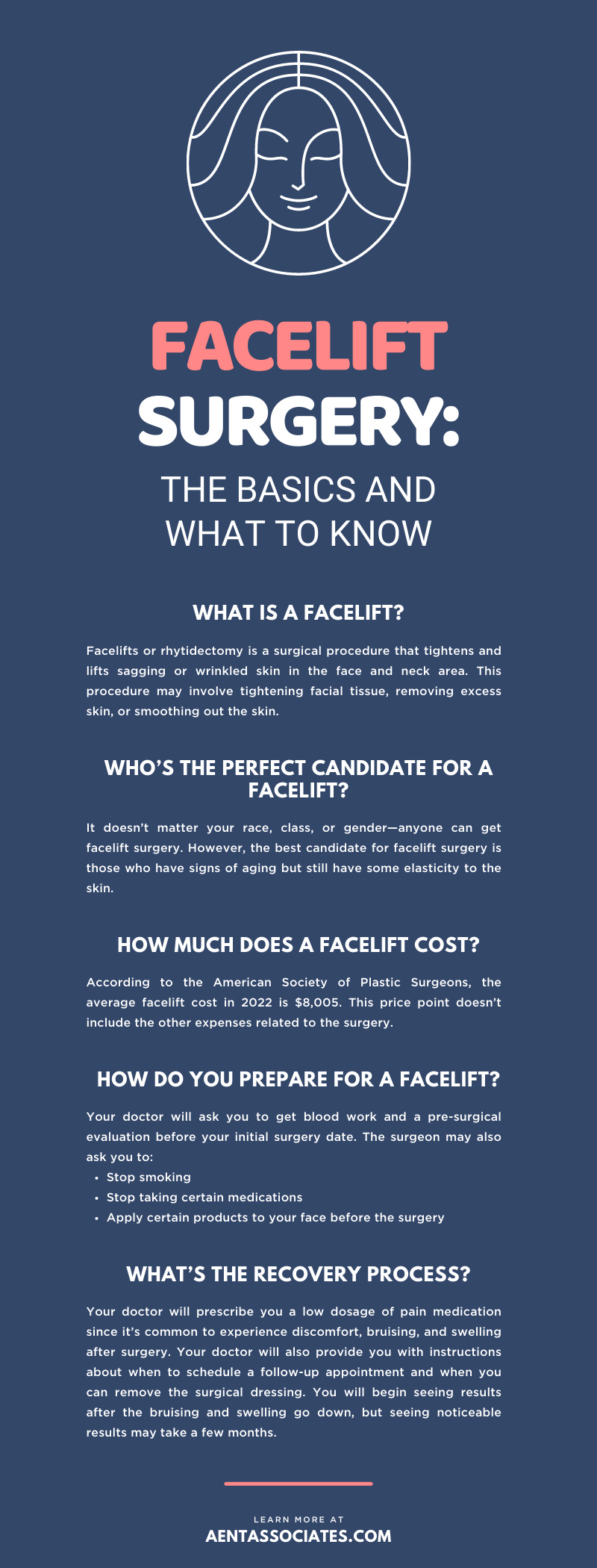
No matter what we do, we’re going to age—it’s normal! But some procedures can help you look ageless. Our skin and tissue naturally lose elasticity as we age, resulting in wrinkles or sagging—which can be undesirable for some. A way to reduce these signs of aging is by getting a facelift, also known as a rhytidectomy. In this article, we will inform you about the basics and what to know about facelift surgery.
What Is a Facelift?
Facelifts or rhytidectomy is a surgical procedure that tightens and lifts sagging or wrinkled skin in the face and neck area. This procedure may involve removing excess skin, tightening facial tissue, removing excess skin, or smoothing out the skin. It’s important to note that facelifts do not include an eye lift or brow lift. However, many people opt to get it done simultaneously.
People get facelifts for many different reasons, but signs of aging that a facelift can improve include:
- Loose skin or extra fat around the neck
- Excess skin on your cheeks or jaw
- Sagging skin on the face
- Deep crease lines
It’s important to know that facelifts are not the cure for aging, and it doesn’t change your overall appearance. Facelifts are unique to the individual and their goals. If your goal is to change multiple elements of your facial features, you would need to get additional surgeries.
Are There Different Types of Facelifts?
Many people don’t know this, but there are different types of facelift surgeries. Several surgical and non-surgical facelift procedures are available to help you achieve a natural and more youthful appearance. Below are popular ways to perform a rhytidectomy.
Traditional Facelift
Traditional facelift surgery involves incisions around your hairline, ears, and chin. The surgeon will then separate the skin from the tissue and tighten the muscles of your face and neck. During the process, the surgeon will remove any excess fat in your neck if needed. In a traditional facelift, the surgeon will also reposition the skin over your face in a natural and flattering way and remove excess skin. This surgery method is best for those with moderate to more visible facial aging looking for more noticeable results.
Mini Facelift
Mini facelift surgery is a less invasive surgery than your typical facelift surgery. Surgeons recommend mini facelifts for younger people with early signs of facial sagging or wrinkling. This procedure uses small incisions under the hairline to tighten and smooth your skin while removing extra facial tissue.
Non-Surgical Facelift
A non-surgical facelift doesn’t involve large incisions or anesthesia, but it does help target multiple signs of aging. They can help target sagging skin, dull skin tone, and wrinkling. These non-surgical options include:
- Injectable therapies
- Micro-needling
- Ultherapy
- Chemical peels
- Microdermabrasion
- Laser skin resurfacing
Who’s the Perfect Candidate for a Facelift?
It doesn’t matter your race, class, or gender—anyone can get facelift surgery. However, the best candidate for facelift surgery is those who have signs of aging but still have some elasticity to the skin. Typical candidates are around 40 to 60 years old. But younger individuals can also be candidates for the procedure.
If you have the following qualities, you will be a good candidate for facelift surgery.
- Is mentally healthy and has realistic expectations
- Doesn’t smoke cigarettes
- Physically healthy, so the body can heal properly
Are There Risks or Side Effects?
With any medical or cosmetic procedure, there are risks involved. These risks include:
- Infection
- Bleeding
- Blood clots
- Hair loss at the incision areas
- Healing complications
- Swelling
- Infections
- Anesthesia risks
It’s always important to talk to your surgeons and doctors about all the risks involved to ensure that this procedure is safe for you.
What Should I Expect During the Consultation?
During your facelift consultation, you will sit down with a surgeon and talk for about 15 to 20 minutes about the surgery you’re interested in. This is the perfect time to ask questions and express some concerns.
The surgeon will review your medications, personal and family medical history, and surgical goals. They will address any alternatives to facelift surgery or risk factors such as smoking.
How Much Does a Facelift Cost?
According to the American Society of Plastic Surgeons, the average facelift cost in 2022 is $8,005. This price point doesn’t include the other expenses related to the surgery. So, you should work out a budget that provides for more than the initial cost. These extra fees include the following:
- Medical tests
- Post-surgery supplies
- Anesthesia fees
- Surgeon fees
- Facility/hospital expenses
- Medications
How Do You Prepare for a Facelift?
Like preparing for any surgery, facelift surgery requires you to prepare before heading into the operation room. Your doctor will ask you to get blood work and a pre-surgical evaluation before your initial surgery date. The surgeon may also ask you to:
- Stop smoking
- Stop taking certain medications
- Apply certain products to your face before the surgery
Whether your procedure is at a specialized surgical center or the hospital, someone must drive you to and from the location. Having a caregiver to help for a few days after the surgery would also be a good idea.
What’s the Recovery Process?
Before the surgery, your surgeon may brief you on the recovery process, but they will also remind you afterward. Your doctor will prescribe you a low dosage of pain medication since it’s common to experience discomfort, bruising, and swelling after surgery.
Your doctor will also provide you with instructions about when to schedule a follow-up appointment and when you can remove the surgical dressing. You will begin seeing results after the bruising and swelling go down, but seeing noticeable results may take a few months.
To help get the best results, you should moisturize your face daily, drink lots of water, and protect your skin from excessive sun exposure. Give yourself two to three weeks to rest before returning to your normal activity. But wait about a month before attempting to participate in vigorous activities.
Allergy & ENT Associates are here to help you feel and look your best. If you’re interested in getting a facelift procedure, contact our facial plastic surgeons in Houston, Texas, to make a consultation appointment today. For additional questions, don’t hesitate to contact our office.




